| This page is a featured article and considered to be one of the best articles about Brunant. |
| Ambroos I | |
|---|---|

| |
| Vital statistics | |
| Name | Ambroos Philip van Draak |
| Birth/Death | August 9, 1762- Sept. 22, 1823 |
| Reign | 29 April 1800 - 22 September 1823 |
| Consort | Queen Caroline |
| Predecessor | Adrian II |
| Successor | Cristian I |

| |
Ambroos I (born Ambroos Philip van Draak; 1762, Grijzestad - 1823, Koningstad) was the 11th King of Brunant from 1800-1823. Ambroos is known as "De Grote" (the Great), for his contributions to the military, literature and politics.
King Ambroos had famously defied James Carrington's rule in his earlier life but was still made the king. He spearheaded several reforms, including the passing of a constitution in 1802[1] Ambroos has since become among the most famous kings of Brunant and is remembered for his contributions to the country.
Life[]
Early life[]
Prince Ambroos was born in Grijzestad Palace to Prince Adrian and his wife, Henrietta Marie. His father was the only son of Princess Catherine, sister to Pieter I and Maximilian, the son of Jan III Sobieski of Poland. His mother was born to the Spanish Marchioness of San Saturnino. The baby prince was given a Dutch name in honor of their country, despite speaking only German and Spanish at home.
As a boy young Ambroos traveled to Spain, Prussia, Poland and other European nations. The prince took his education with various tutors, among them the scholar Hendrik Vandelet (a distant ancestor of the painter Michael Vandelet). Ambroos took an interest to writing, which he was able to indulge in.
Young Ambroos was enrolled at university in France at the age of 17. He studied literature and politics in Paris. In late 1783 Ambroos finished his schooling and returned to Brunant.
Military career[]
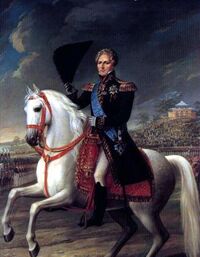
Ambroos I on horseback, 1821
Prince Ambroos was appointed a Captain over 500 soldiers stationed in Sint-Anders. When James Carrington invaded Brunant in 1784 he led a gallant defense of the town, but could not resist a massive attack a few weeks later. As the king's nephew's son, he was not expected to become the king. All this changed when his great-uncle was swiftly deposed and his father was appointed king. Ambroos, though, led various insurgencies against Carrington, notable in 1786 and 1791 and was even arrested in 1792[2]. He later made his peace with Carrington and even held a position in the Royal Guard from 1795. That year the king officially opened the Royal University of Koningstad, having been one of the main proponents for an institute of higher education in the capital [3]. He served as the school's first chancellor, from October 7, 1795 to 3 June 1801[4]. In 1803 he was reinstated as honorary president for life.
Reign[]
Early reforms[]
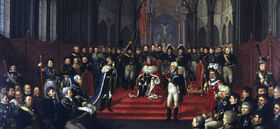
King Ambroos' Coronation, 1800
In 1800, James Carrington deposed King Adrian II. Adrian had become more resistive to his policies had led a coup against him. Carrington felt that Ambroos would cooperate more. Ambroos was crowned at Koningstad on April 29, 1800 at St. Peter's Church. Ambroos was highly critical of Carrington's militaristic rule and did not get along well with the old leader. Upon Carrington's death, Ambroos brought his father back from exile and re-honored him. King Ambroos quickly took advantage of the lack of support for the new president, David James Carrington; Ambroos never supported him and his policies. The king came to dominate government and was interested in writing a new constitution. The king was instrumental in writing and adopting the Constitution of 1802; he wrote many of its clauses and strove to limit the role of the President. Cunning King Ambroos found support from reformists and the old royalists led by Walter van der Ecke and Frans Jordens. He quickly became known as the "people's king", since he gave many speeches in public and held more audiences than his predecessors combined. He was known for giving to charities and the church and became a well-respected figure.
In the early 1800s, his power was questioned by some Petrists. Some people supported Count Daniel of Leiningen-Dagsburg or Queen Hélène II of Cettatie as the rightful ruler of Brunant. In 1807, Hélène launched an invasion and briefly occupied the town of Sint-Hendrikstad, but after her death, her son made no claim to the Brunanter throne.
The new age[]
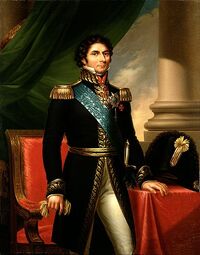
King Ambroos
In 1809 the king managed to oust Carrington from the presidency and replaced him with staunch royalist van der Ecke. Though the younger Carrington married his daughter Victoria in 1810 he would rarely talk to him at formal or private events. On the other hand, he got along excellently with President van der Ecke; the two would go on hunting trips together and he would often be present at family affairs. Ambroos, though, still held a lot of power and was quick to use them when things weren't going his way. Despite having introduced a constitution, he was the most powerful king of the post-Carrington era with near-absolute powers[5]. The King was supportive of van der Ecke's declaration of war against Napoleon. He was quite weary of French expansionism and quickly allied himself with Prussia[6][7] The King, in an unprecedented occasion decided to go to Europe in 1814 and command the Brunanter troops. Along with Marshal Owen Halsey MacLellan and Jordens, he led troops in a combined operation with the Prussians. The King sustained a musketball shot to the leg which caused him much problems in later life [8].
Later life and death[]
After the war King Ambroos became a more reserved man and made less frequent public appearances. The crown prince took over many of his duties. His war wound was causing him some problems and soon he had various other illnesses. Ambroos I died in 1823 at the Realpaleis, surrounded by his children and grandchildren. He left the throne to his eldest son, Cristian I, who would rule for 36 years.
Family[]
Prince Ambroos was engaged in 1777 to Caroline of Saxe-Coburg-Saalfeld (1762-1828), when they were both fifteen. His bride-to-be was the daughter of Ernest Frederick, Duke of Saxe-Coburg-Saalfeld and aunt to Leopold I of Belgium and Marie Luise Victoria, the mother of Queen Victoria. On 1 August 1781 the couple were married in a beautiful ceremony at St. Peter's Cathedral, the place where he was crowned. It was generally believed that their marriage was purely for political purposes, since Caroline came from an important family, but many love letters have been found written between the two[9], meaning likely that they truly fell in love. Since Ambroos was still off studying in France, Caroline remained in Brunant since she did not want to move there. Caroline gave birth to twin daughters when Ambroos was away. The couple were re-united in 1783 when he finished. Unlike many of his predecessors and descendants, he never took mistresses and remained faithful to his wife. He and Caroline would have the following nine children:
- Princess Cristina Maria (1782-1805), married to Ernest Augustus I of Hanover.
- Princess Augustina (1782-1833), married Charles Handley (1780-1820) and had issue.
- Princess Helena (1784-1821), married to her cousin King Martin I of Libertas and had issue.
- Princess Victoria (1786-1838), married to David James Carrington and had issue.
- Cristian I (1787-1859), married to Maria Francesca of Naples and Sicily and had issue.
- Princess Louisa (1790-1884)
- Princess Maria (1792-1863), future Queen of Strasland.
- Prince Johan Alexander (1794-1855)
- Princess Juliana (1795-1870), married to Alexander von Krupski and had issue.
Ambroos only had two sons, but he was extremely fond of his daughters, especially Princess Helena. The king was quite devastated upon her death in 1821.[10]. Ambroos pampered his daughters and was seen as a family man, devoted to his wife and children.
Personal life[]
Poetry[]
Though King Ambroos was known to many as a brave military hero, he was secretly also a man of the pen[11] Ambroos kept his writings to himself and very few people knew that he was an avid poet. In 1923 William Marsdale released an edited book called 66 Poems and Verses, a compilation of King Ambroos' previously unpublished and unreleased work. [12]
Antiques collecting[]
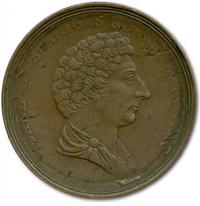
4 cent piece, 1819
Ambroos was an avid collector of antiques during his life. The king kept a few antique weapons and firearms, but his passion was coin collecting. He built up an impressive collection of gold, silver and copper coins, ranging from ancient Greek and Roman pieces to contemporary coins bearing his likeness. Much of his collection was donated to the State Museum in Koningstad, though a few early medieval coins were sold off.
Language[]
King Ambroos spoke various languages. His maternal language was German, which his father spoke, and knew Spanish as well. At a young age he learned Dutch and some Polish, and later on he would learn some French and Latin, while in Paris. Ambroos never learned English and was not fond of English culture.
Legacy[]
Ambroos I is considered by many to be the greatest monarch. During his short reign he helped modernize the country, and introduced new technologies. He was vital in writing the constitution of Brunant and getting David James Carrington to sign it. In 1804 he wrote a poem, which would later serve as the basis of the lyrics for the national anthem of Brunant.
No king of Brunant has since named their child Ambroos for fear of not living up to the name. To date, no prince has been named Ambroos and there has not been an "Ambroos Van Draak" since then[13].
Ambroos was commemorated throughout the country for his deeds. Many cities and town like Grijzestad and Koningstad have statues of the King in the old plazas. The State Museum has a section called the "King Ambroos Hall", since Ambroos donated many artifacts to the museum. Ambroos Station in the Arabian Quarter of Koningstad is named after him as well, as is the Koning-Ambroos Library of the RUK and the prestigious Ambrosian College. Other things mame in his honor include The Ambrosian Hills, a winemaking region in Sint-Anders Parish[14] and Ambrosian FC, a football club that finished third in the AFC league in 1938 and 1940.
Descendants[]
Ambroos I and his wife are direct ancestors of alle monarchs in the wikinations. He is a direct male-line relation to Brunanter Queen Helene, via his son Cristian. He is direct ancestor of King Sebastian of Lovia, via his daughter, Princess Augustina. Ambroos is ancestor to King Oscar III of Strasland via Princess Maria, who was elected Queen of Strasland and to King Hendrik of Libertas, a half-uncle who married his daughter, Princess Helena. Furthermore, via his granddaughter Gisela, he is related to the deposed Traspesian Royal family and the current pretender. He is also an ancestor of the Kemburger and Cetatian royal families.
Titles and styles[]
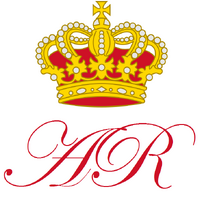
The King's monogram
1762 – 1784 Prince Ambroos of Brunant
1784 – 1800 His Royal Highness, Crown Prince Ambroos of Brunant
1800 – 1823 His Majesty The King of Brunant
Awards and honors[]
Ambroos held various honors and awards throughout his lifetime. They include:
- Grand Cross of the Order of St. Andrew, awarded 1800[15]
- Medaille d'Honneur en Guerre, awarded 1805
- War Cross, awarded 1808[16]
- Knight of the Order of the Golden Fleece (Spain), awarded 1807
- Grand Cross of the Order of the Tower and Sword of Portugal, awarded 1813
- 1814 War Medal
- Knight of the Order of the Garter, Great Britain, awarded 1815
- Pour le Mérite (Orden Pour le Mérite, the "Blue Max"), Prussia, awarded 1815
In Popular Culture[]
Direction: Emperor Ambroos's Tale was a serial based on the Golden Age of his life.
Ancestry[]
Ambroos' origins are mostly Spanish, since the Van Draak's and most of his other ancestors were from the German states or Iberian peninsula. His great-grandfather was king of Poland (and his family were Polish).
Ancestors of Ambroos I
| 16. Jakub Sobieski (1590-1646) | ||||||||||||||||
| 8. Jan III Sobieski (1629-1696) | ||||||||||||||||
| 17. Zofia Teofillia Daniłowicz (1607-1661) | ||||||||||||||||
| 4. Maximilian Jan Sobieski (1684-1766) | ||||||||||||||||
| 18. Henri Albert de La Grange d'Arquien (1613-1707) | ||||||||||||||||
| 9. Marie Casimire Louise de La Grange d'Arquien (1641-1716) | ||||||||||||||||
| 19. Françoise de La Châtre (1615-1672) | ||||||||||||||||
| 2. Adrian II (1733-1807) | ||||||||||||||||
| 20. Karl Van Draak (1631-1709) | ||||||||||||||||
| 10. Marten I (1665-1744) | ||||||||||||||||
| 21. Isabella of Parma (1641-1712) | ||||||||||||||||
| 5. Princess Catherine of Brunant (1704-1778) | ||||||||||||||||
| 22. Louis, Grand Dauphin (1661-1711) | ||||||||||||||||
| 11. Louise of France (1681-1705) | ||||||||||||||||
| 23. Maria Anna Victoria of Bavaria (1660-1690) | ||||||||||||||||
| 1. Ambroos I | ||||||||||||||||
| 24. ? Quindós | ||||||||||||||||
| 12. Álvaro de Quindós y Lamas | ||||||||||||||||
| 25. ? Lamas | ||||||||||||||||
| 6. Álvaro de Quindós y Bolaño | ||||||||||||||||
| 26. ? Bolaño | ||||||||||||||||
| 13. María Andrade Bolaño Pimentel | ||||||||||||||||
| 27. ? Pimentel | ||||||||||||||||
| 3. Enriqueta Maria de Quindos y Reynoso (1736-1767) | ||||||||||||||||
| 28. Francisco Álvarez de Argiz | ||||||||||||||||
| 14. Pedro Álvarez de Reynoso y Argiz Galloso y Feijoó (d.1702) | ||||||||||||||||
| 29. Antonia de Zúñiga Gayoso y Reynoso | ||||||||||||||||
| 7. Rosa Álvarez de Reynoso y Andrade | ||||||||||||||||
| 30. Pedro de Andrade e Castro (1596-1652) | ||||||||||||||||
| 15. Francisca Ventura de Andrade y Pardo de Figueroa | ||||||||||||||||
| 31. Francisca Pardo de Figueroa | ||||||||||||||||
Picture gallery[]
See also[]
Notes[]
- ↑ This was the first constitution in Brunant since the Grijzestad Constitution of 1427.
- ↑ Ambroos was placed under house arrest from August 2 to October 7, 1792 at Grijzestad Palace
- ↑ The King Ambroos Library at the university, inaugurated in 1837, was named in his honor
- ↑ In a letter sent to the university officials, he stated that his duties as king did not permit him to carry out his activities as chancellor and thus resigned
- ↑ Modern day detractors have labelled him a control freak unwilling to come to terms with the failure of absolutism.
- ↑ Less than sixty years earlier France invaded Brunant and this was still not forgotten. Many also feared another French invasion and believed that pre-emptive activity (ie. an alliance with Austria or Prussia) had to be taken on Brunant's part.
- ↑ Ambroos held audiences with a few remaining veterans of the Franco-Brunanter War and they urged him to stand firm against the French.
- ↑ It was generally agreed by his physicians that his gunshot wound led to his early death
- ↑ Written from 1781-1816
- ↑ The death of Helena affected him more than that of Princess Cristina Maria in 1805
- ↑ In an note dated to 1817 he wrote that he considered himself an "homme du plume" and enjoyed writing poems and verses.
- ↑ The book was published on the centennial of his death. Many Brunanters celebrated their greatest king and his achievements that year.
- ↑ unless one counts his son, King Cristian who was named Cristian Leuvis Ambroos Maria Van Draak
- ↑ The Ambrosian Hills is considered the finest region for winemaking in the country
- ↑ The Grand Cross of the Order is only awarded to the reigning monarch, as soon as he is crowned
- ↑ To date he is the only Brunanter monarch to have received this award.
- ↑ This colored engraving is based on the portrait by Hans Rotmensen of 1817
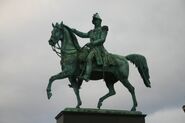

![King Ambroos I.jpg (17 KB) Ambroos I, 1819[17]](https://static.wikia.nocookie.net/carrington/images/2/20/King_Ambroos_I.jpg/revision/latest/scale-to-width-down/133?cb=20120416131317)